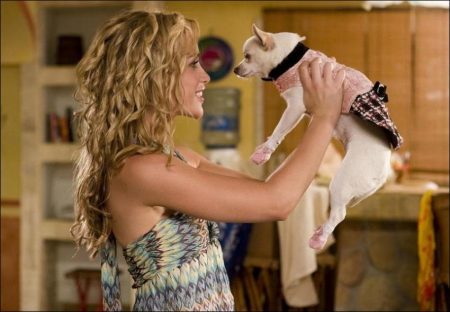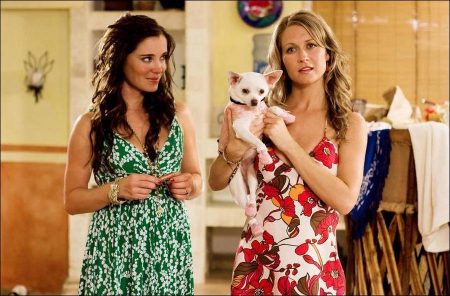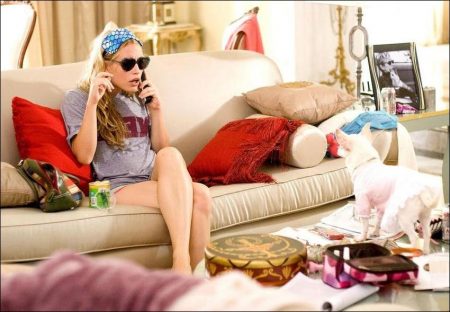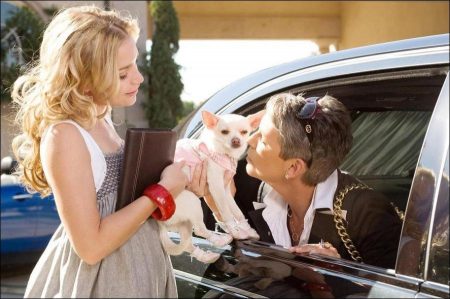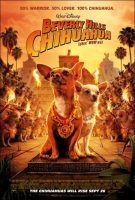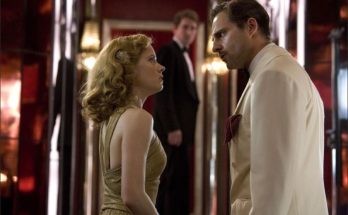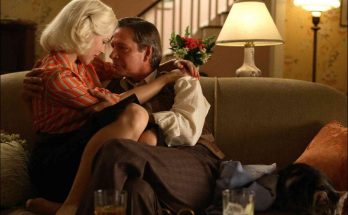In the Disney comedy “Beverly Hills Chihuahua,” Chloe (voice of Drew Barrymore), a diamond-clad, bootie-wearing Beverly Hills Chihuahua, enjoys her luxurious lifestyle so much, she hardly notices Papi (voice of George Lopez), a Chihuahua who happens to be crazy for the pampered pooch. But when Chloe gets lost in Mexico with only a streetwise German Shepherd (voice of Andy Garcia) to help her find her way home, Papi heads south of the border—joining forces with a motley crew: three dogs (voices of Placido Domingo, Luis Gusman and Eddie ‘Piolin Sotelo), two humans (Piper Perabo, Manolo Cardona), a sly rat (voice of Cheech Marin) and a nervous iguana (voice of Paul Rodriguez)—to rescue his true love.
A story about finding yourself and being true to who you are and where you come from, this liveaction adventure also features actors Jamie Lee Curtis as Aunt Viv, Jose Maria Yazpik as baddie Vasquez, Maury Sterling as Rafferty, Jesus Ochoa as Officer Ramirez, and Eugenio Derbez as the store owner. Edward James Olmos is the voice of the menacing Doberman El Diablo, Loretta Devine is the voice of snooty Toy Poodle Delta, and Michael Urie is the voice of pompous Pug Sebastian. But the real stars of the show just may be the truly international, impeccably trained, lovable canine cast — more than 200 in total — including many mutts and a variety of breeds— Dobermans, German Shepherds, Chihuahuas, Poodles, Pugs, Chinese Cresteds, a French.
Beverly Hills Chihuahua is a 2008 American family comedy film produced by Walt Disney Pictures, the first in the Beverly Hills Chihuahua series. It is directed by Raja Gosnell and was released on October 3, 2008. The films stars Piper Perabo, Jamie Lee Curtis and Manolo Cardona as the human leads and Drew Barrymore, George Lopez and Andy Garcia in voice-over roles. The plot centers on a Chihuahua, Chloe, who gets dognapped in Mexico and has to escape from an evil Doberman, El Diablo, with a help from a lonely German Shepherd, Delgado and a hyperactive male Chihuahua, Papi, who has a desperate crush on her. A sequel, Beverly Hills Chihuahua 2, was released on direct-to-DVD on February 1, 2011, and Beverly Hills Chihuahua 3: Viva la Fiesta! was released on September 18, 2012.
Filmmakers Blend Humor, Fun and Positive Messages
The stage is set for “Beverly Hills Chihuahua” when Chloe’s loving and devoted owner Vivian (Curtis) recruits her niece Rachel (Perabo) to care for the pampered pooch during a business trip. But when the reluctant and somewhat irresponsible dog-sitter heads to Mexico on a last-minute weekend getaway with the overindulged Chihuahua in tow, chaos erupts. When Chloe goes missing, Rachel recruits Vivian’s trusted landscaper Sam (Cardona) and his devoted dog Papi to help in the search efforts.
“Chloe lives under the assumption that she must have that life because she deserves it and because that’s her place,” says director Raja Gosnell. “She has no concept of her roots, her heritage, where she as a Chihuahua comes from. She doesn’t embrace her Mexican heritage.”
In contrast, says Gosnell, Papi is well aware of his roots and has a solid self-identity. “He knows what he wants.” “Papi is like a little masculine Chihuahua,” says George Lopez, who provides the voice of Papi. “He works with the landscaper, Sam, and he digs holes and helps him out. He sees this beautiful vision Chloe and he falls in love with her.
“In the beginning when they first meet, Papi gets blown off,” continues Lopez. “He tries all his Chihuahua tricks, you know, he rolls over in the dirt and he brings her a grasshopper and he jumps over her friends and, you know, he’s really going at her in a macho way. When he finds out that she’s in trouble, it’s his quest to find his love. His romantic side comes out.”
Indeed, Papi nearly steals the show with his charismatic personality and debonair approach to Chloe. “He’s sort of the noble seeker in the movie—the Romeo,” says Gosnell. “And he pursues Chloe all over Mexico. He never gives up.”
Producer David Hoberman of Mandeville Films liked the idea. “I wanted to make the film because I thought it had really positive messages, like how we judge people before we know them, how we judge cultures before we’ve lived in them, and finding purpose in life.
“It’s a great Disney movie because of the themes of tolerance, self-worth, and finding who you really are inside,” continues Hoberman. “I think the greatest gift we can give an audience is to get everybody thinking and talking. On top of that, it’s a wildly entertaining movie that makes you laugh and cry.”
Producer Todd Lieberman of Mandeville Films believes the story and lessons in the film are universal. “Even though on the surface it’s dogs talking, it’s really about what’s inside— your soul. The basis of the story was really identifiable and recognizable as a human story. Then if you apply that to animals and put dogs in it, it just makes it that much more fun.
“I loved the idea of taking a really grounded, personal, emotional journey and making the lead characters talking dogs,” continues Lieberman. “It’s a family story with funny jokes and cute animals—the whole package.”
“There’s such a long tradition of talking dog films because everyone who has a dog knows it has its own personality,” says writer Jeff Bushell. Chloe’s journey opens her heart to Papi. “During Chloe’s time in Mexico, she symbolically sheds her dress and her booties, but she’s also shedding what she thought she was,” explains Lieberman. “Ultimately, she’s able to accept a dog that she would have never looked at in a million years before, because he was from the pound, not a purebred, and not of her stature.”
Casting Voices, Humans and Virtual Creatures
With a cast that included more than 200 dogs, snakes, pigeons, coyotes, a mountain lion, a virtual pack rat and a virtual iguana—and of course talent of the human variety—the “Beverly Hills Chihuahua” filmmakers had their work cut out for them when it came to filling the roles.
“The way that we put the cast together was very interesting, because it’s a pastiche of animals and humans and we actually cast them simultaneously,” explains producer John Jacobs. “We’d think, ‘Who is the perfect Sam?’ And then we would think, ‘Who is the perfect animal counterpart, and how do they go together?’ Papi is just a hysterically funny, really cool street dog, and is a great counterpart to Sam. We wanted to find characters that mirrored each other. The humans had to be just as exciting as the animals, and the animals had to be as cool as the humans. So we really did it hand in hand.”
A host of talented actors, including some of the biggest Hispanic names in the entertainment world, lend their voices to the canine cast. Says producer Todd Lieberman, “We knew it was important to get recognizable names for the voices of the animals.”
“We have this amazing list of actors who are all movie stars and they’re doing these dog voices,” says director Raja Gosnell. “But it’s not like we had to go and talk people into it. Everyone responded to the script and they all saw that this is not your regular talking-dog movie.”
Lieberman says one priority was to attract the kind of talent that would uphold the film’s largely Mexican setting. First on the list was George Lopez (“Swing Vote,” TV’s “George Lopez”), tapped to voice the crazy-for-Chloe mix-breed Chihuahua who relentlessly pursues his corazón south of the border.
“Papi may be the funniest character in the whole movie,” says Hoberman. “He’s just an incurable romantic who is in love with Chloe and is never shy about professing his love for her, and does it in some very, very funny ways. He’s the guy who would probably never get this girl, but because of his persistence, he does at the end. George is just funny and I think we’ve gotten the right Chihuahua to work with him.”
Adds Lopez, “Papi is a little bigger than most Chihuahuas. He’s a little masculine Chihuahua. When he runs, he hops. I don’t think I’ve seen a Chihuahua hop like a bunny before.
“Papi is nothing like me,” continues Lopez. “He’s a romantic dog, yet he’s got a little bit of street in him. I got the street, but I don’t really have the romance. So, I admire the dog. His face is really expressive, so I wanted to make that face come to life. The dog had already done so much with that character that I had to up my game to give that dog what he deserved. He’s working so hard in Mexico that I didn’t want to let him down with the voicei.”
Director Gosnell had previously worked with actress Drew Barrymore (“Charlie’s Angels,” “50 First Dates”) on the hit comedy “Never Been Kissed” and thought she was perfect to voice Chloe. “I pitched the script to her and she just said, ‘Let’s do it!’”
Screenwriter Bushell actually wrote Chloe with Drew Barrymore’s voice in mind. “You don’t want Chloe to come off as completely unlikable. Drew has this natural sweetness to her and this real genuine quality in her voice. She is one of the few people who can actually make our character have that edge, but still be lovable and sweet.”
Barrymore, an animal lover, added something special to the character, says Jacobs. “When we saw Drew reading the character, Chloe just came to life, and everybody fell in love with the character on the spot.”
“It was fun to play someone who starts off kind of snooty and righteous,” says Barrymore. “She thinks she knows what life is all about and gets humbled along the way.”
Andy Garcia (“La Linea,” “Ocean’s Eleven”) was called on to provide the voice of Delgado, the street-wise German Shepherd and former police dog who lends a paw to Chloe. The dog, dignified and loyal, longs for his days on the force. “You know, once a police dog, always a police dog,” says Garcia. “Delgado has a heart, he has a noble and heroic side to him and he can’t help but try to get this little Chihuahua back home.”
Garcia didn’t utter a line before meeting Samson, his onscreen counterpart. “I asked to meet the dog, so they brought him to my house and we played like dogs,” says Garcia. “I took some pictures of him and tried to get a sense of what his temperament was and how he moved.”
The filmmakers approved of the process—and the actor. “The thing about Andy that’s great is his authenticity,” says Hoberman. “He’s gruff and tough and macho, but he’s got a sense of humor.”
Hoberman says the real magic set in when Garcia joined Barrymore for a recording session. “To see them both in the room and how they interacted with each other was great. It was a perfect combination.”
Edward James Olmos (“Stand and Deliver,” “Selena”) provides the voice of the menacing Doberman El Diablo, the dog that the greedy and villainous Vasquez summons to track down Chloe and Delgado.
“This dog can’t be stopped—he tracks them from Mexico City to Puerto Vallarta,” says Gosnell. “And he has this mysterious history with Delgado—when Delgado was the police dog and El Diablo was this dog version of the bad guy, a criminal.”
And though the filmmakers won’t say they found similar qualities in the actor chosen to voice the role, they tip their hats nonetheless. “Edward James Olmos is just a classic and lends a real gravity to the role,” says Jacobs.
Virtual creatures Manuel the pack rat and Chico the iguana are entirely computer animated and the colorful pair serve as both friends and foils to Chloe and Delgado. Tapped to voice the roles are Cheech Marin (“Up in Smoke,” “Born in East L.A.”) and Paul Rodriguez (“Ali,” “Bloodwork”).
“Cheech and Paul play Manuel and Chico, who are the lovable, comedic villains in the piece, who are always trying to steal Chloe’s diamond necklace. I think the two of them together are just funny,” says Hoberman.
Providing voices to three dogs who try to help Chloe on her journey home are Plácido Domingo (“La Traviata,” “Otello”), Luis Guzmán (“Humboldt Park,” “Yes Man”) and Eddie “Piolin” Sotelo (“Piolín por la Mañana”).
Domingo lends his voice to Monte, a Chihuahua leader who opens Chloe’s eyes about her culture; Guzmán voices a cantankerous Pit Bull mutt who learns the meaning of home; and Sotelo is the voice of Rafa, a nervous Mexican street dog with a heart of gold. Loretta Devine (“Crash”) and Michael Urie (“Ugly Betty”) provide the voices for two of Chloe’s uppity canine friends, Delta and Sebastian.
For the live-action roles, filmmakers found the perfect Rachel and Sam in vivacious actress Piper Perabo (“The Prestige,” “Because I Said So”) and the rapidly rising Latin-American star Manolo Cardona (“La Mujer de mi Hermano”).
“Rachel’s the least likely candidate to take care of this dog, she can barely manage her own life,” explains Gosnell. “She can’t seem to keep a job, not because she’s not smart, not because she doesn’t have a great heart, but because she’s a little lost. Rachel lives in this Beverly Hills bubble the same way Chloe does, and she hasn’t found what is important in her life and doesn’t really realize that something’s missing.”
“Piper was our first choice for the role,” says Hoberman. “She brings optimism and energy both on and off the set. She’s just a real life force in the movie.”
“Rachel’s a little flaky, a little distracted, and maybe a little selfcentered,” says Perabo. “She hasn’t really grown up yet and doesn’t know what she wants to do with her life. She can’t really take care of herself, so taking care of anything else is next to impossible.”
“Piper managed to instill that character with a soul, bringing depth to what could have been a really cardboard character,” says Gosnell. Cardona tackles the role of Sam. “Sam is the soul of the movie,” says Gosnell. “He and Papi are very centered characters. They know who they are, they know what they want, and they’re very content in their lives and in their work.”
“Manolo is just an incredibly charming guy,” says Gosnell. “Sam is the noble character, the teacher as opposed to the student, and Manolo has really brought a level of maturity to that character and a level of soul that is an intangible in the script. We looked at other actors and we just didn’t feel that they had the depth that Manolo brings to the character.”
“Manolo Cardona is also pretty sexy, I gotta tell ya,” laughs Perabo. “He’s a lot like Sam. He’s very smart and very serious and has an intelligent, grounded quality. The integrity that Manolo brings to Sam really makes the character real.”
“When you cross the border for the first time, it can be an amazing experience,” says Cardona. “Rachel feeling another world is part of the adventure. When you really start trying to accept other people, that’s when you’re really living life.”
Tapped to play Vivian, the aunt who inadvertently sets the whole story in motion, is actress Jamie Lee Curtis (“True Lies,” “A Fish Called Wanda”).
“Jamie just has such an amazing energy, on camera and off camera. She really made Viv real,” says Gosnell. “The character is a little bit loony—this is a person who buys her Chihuahua a diamond necklace. Jamie plays her eccentricity with so much charm.”
Curtis was pleased to be a part of the project. “I loved this story and I just thought it had all the stuff that I look for in a family movie,” she says. “I love dogs. And I loved Viv and her energy and her love of this dog. It’s funny and poignant.”
José María Yazpik (“Las Vueltas del Citrillo,” “Only God Knows”) was cast as the baddie Vasquez. “He has incredible range as an actor,” says Gosnell. “He’s got movie-star good looks. He is a leading man, so we’re so lucky that he decided to play this role for us. I think he enjoyed the idea of playing a bad guy.”
The character Vasquez is out to capture Chloe because he’s convinced she’s worth a lot of money and he’ll stop at nothing to get her. “José just managed to take this character, who is not in a lot of scenes, and instill so much menace and believability,” says Gosnell.
Handsome American actor Maury Sterling (“Smokin’Aces”) portrays Vasquez’s henchman Rafferty, who gives chase to the dogs all over Mexico. “Maury has this comedic timing, so he brings freshness to the set and he’s always smiling and trying to learn Spanish,” says Yazpik. “He’s just a fun guy.”
Jesús Ochoa (“Padre Nuestro,” “Paraiso Travel”) plays Officer Ramirez, the cop who Rachel begs to help her motley crew find Chloe. Says Gosnell, “Jesús Ochoa is a legend in Mexico. He doesn’t even need to open his mouth and he has this incredible screen presence. He’s been in many amazing movies, usually playing bad guys. So now he’s the good-guy cop and I think he relishes playing a good guy. He gets to be funny and warm. Even though he’s the overworked big-city cop, he finds a lot of heart and gets involved in the search for this little Chihuahua.”
Eugenio Derbez, another giant figure from the Mexican entertainment world, plays the store keeper. “It’s a small part, but he made a real big meal out of it,” says producer Todd Lieberman. “He’s just huge, especially in Mexico. We’re shooting at this little storefront and, literally, mobs of people are surrounding this guy, asking for autographs and yelling and screaming. It was unbelievable.”
Casting Canines
Filmmakers called on head trainer/animal coordinator Mike Alexander (“Eight Below”) of Birds & Animals Unlimited for his ability to get organic and real performances from his furry and feathered actors.
For the specific leadingcharacter dogs, filmmakers wanted to cast fresh faces. Alexander and his team spent months networking to find the special stars and one of the biggest resources proved to be shelters. In fact, the Chihuahua tapped for head hound Papi was rescued from a shelter. Alexander says it was his big ears and great expression that drew the trainer and the filmmakers to the part-Chihuahua, part-mutt mix. “We saw his picture online and called the shelter. They said he’d been there a while.” Alexander immediately drove to the shelter, but it had already closed for the day. “We’d been looking for a dog like that for so long, I was ready to spend the night in the parking lot.” Fortunately, Alexander was able to adopt “Rusco” on the spot the following morning. Rusco has since found a permanent home at his trainer’s sevenacre ranch outside of L.A.
Says producer John Jacobs, “People can get very caught up in whether a dog is purebred and it really doesn’t matter. A great dog is a great dog. The trainers could train the dogs found in rescues, and within six months, these dogs were performing like superstars. It really goes to show if a dog is given a good home he can be the best dog in the world.”
“Beverly Hills Chihuahua” features a truly international cast of dogs and a variety of breeds—Dobermans, German Shepherds, Chihuahuas, Poodles, Pugs, Chinese Cresteds, a French Bulldog, a St. Bernard, a Labrador, a Border Terrier, a Dachshund, a Boston Terrier, a Yorkie, a Beagle, a Dalmatian, a Border Collie, a Pomeranian, a Bichon and a Pekingese.
Some were found at rescues in Los Angeles and Mexico—some were seasoned Hollywood dogs. Half of them understand Spanish, half of them understand English. In addition to more than 200 dogs, the film features appearances by many different types of animals, including snakes, pigeons, coyotes and a mountain lion.
Director Gosnell says he recognizes the value in working with real animals. “What really impresses me most about the animals is the soul behind their eyes. In the CGI world your characters can do amazing things, but there’s never that same soul. I think that’s the most special thing about working with real animals—even if they’re just sitting there, there’s a soul back there and you can really feel it.”
Alexander admits he was concerned when he first read the script. “It’s one of the best animal scripts I’ve read in a long time, but it’s incredibly bold. Every time I would turn the page, I would think to myself, ‘Well this has gotta be the hardest gag in this movie.’ And then the next page, ‘Oh well, this is the hardest gag in this movie’—on and on, all the way to the end.”
Alexander led a multi-national team that at times swelled to more than 60 trainers to prepare and care for the animals that appear in the movie. There were 11 character teams—look-a-like animals and two trainers—to portray the main animal characters in the film. Additionally, there were other large canine groups trained to play the Mexican street dogs, the Chihuahua Nation dogs, the Beverly Hills spa dogs, and the Police Academy dogs, as well as the noncanine animals.
Alexander drew upon the best animal-training talent in the world to work on the project, assembling handlers from Southern California, Florida, Montana, New Jersey, Virginia and Nevada, as well as Canada and Mexico.
Trainers used repetition and positive reinforcement techniques, a tactic that impressed filmmakers. “It’s incredible to watch Mike and his crew work,” says producer John Jacobs. “They have a way of encouraging dogs so that the dogs respond incredibly. I’ve never seen anything like it.”
Jamie Lee Curtis agrees. “There are moments that really do take your breath away,” she says. “The way Angel works with Mike is amazing. The minute the camera cuts, she’s looking around for Mike: ‘Where’s my dad?’ It’s a beautiful relationship that they have and it just makes you feel confident that she’s totally happy. He obviously cares about her a great deal.”
When it came to casting the dogs, Alexander says he looked for dogs with really wonderful personalities. “Outgoing and confident are the two most important qualities,” he says. “The dogs had to learn a lot of complicated behaviors, so we needed thinking dogs. We needed dogs that had strong personalities and smarts. We like a dog that can learn how to learn.”
Gosnell had some experience working with animals, but says this film is different. “Their journey is a very human one and their characters have very human needs, wants and failures. For a talking-dog movie, it’s a very humanistic story. They have human feelings and human emotions and human souls, but we’ve been very conscious not to push the envelope and make them Super Dog. These are real dogs that do things that real dogs can do.”
The pampered Chloe character called for a white Deerhead Chihuahua named Angel. Angel had four doggie doubles who were trained to do specialty behaviors like swimming and running. Alexander admits that Angel is a bit snooty in real life, just like her character. “You can see it when you work her,” he says.
Six German Shepherds make up the Delgado team with Samson starring as the face dog. Two of the Shepherds are from rescues in Los Angeles, one actually came from Germany, and another from a man who trained police dogs in Los Angeles. Samson does the lion’s share of the work portraying Delgado, but since the role is very physical and involves a lot of running, filmmakers had the look-a-like German Shepherds standing by in case Samson got tired.
Trainers traveled to Serbia, Russia, Croatia, Hungary and Italy to find the four Dobermans to portray the villainous El Diablo, with Arad taking the lead. Originally a protection dog, Arad became so affectionate with training that it was hard to believe he was playing the baddie.
Nearly 50 Chihuahuas with a wide variety of appearances from the United States and Mexico City were called on to create the Lost City of Techichi scenes where a wild Chihuahua Nation lives in seclusion, and a team of 40 authentic Mexican street dogs were recruited from a shelter outside Mexico City to play Mexican street dogs in the film. Alexander says they were especially pleased with finding the street dogs. “We found a guy who is a self-proclaimed spiritual savior of Mexican street dogs and he had about 200 dogs living in a compound facility up in the mountains. This man truly loved these dogs and one of the reasons that I chose that particular facility is that he let them all live together. A lot of the trainers came to love these dogs, so much that several of them were adopted and brought home to America.”
For the many months of prep and shooting on location in Mexico, filmmakers created dog compounds in both Puerto Vallarta and Mexico City to house and train the animal actors. Initially a core group of about 75 dogs and 30 trainers arrived in Puerto Vallarta to prep the film, so constructing an appropriate compound—one with large exercise runs, places to prepare and store food, individual kennels for each dog, facilities in which to bathe the dogs, and open space—was a huge endeavor.
The American Humane Association was on set to monitor all the animal action in the film, ensuring the safety of the animal actors, especially from the summer temperatures. The AHA rep and the trainers watched each canine actor for signs of overheating. Pads of the paws were checked regularly for wear.
“Our company has been providing trained animals for the motion picture, television, commercial and entertainment industry for more than 40 years,” says Alexander. “All of our animals are trained with positive reinforcement, play, lots of attention, love and interaction with people and places. Most of our trainers have been working with us exclusively for 16-18 years. We truly enjoy what we do and the animals become a part of our families. We provide the animals really amazing homes with us—plus more time, interaction and positive stimulation than a lot of pets receive.”
According to Alexander, after filming wrapped, the animals cast from rescues—ranging from Rusco, the dog who played Papi, to the German Shepherds tapped for the Delgado role, to many of the Mexican street dogs borrowed from a wonderful no-kill shelter in Mexico— came home to live with their Birds & Animals Unlimited trainers. In some cases, animals were adopted by cast and crew members, or were placed in other loving homes.
On Location: Filmmakers Take the Pooch Production South of the Border
Shooting primarily on location in a foreign country required intense collaboration between the filmmakers, the creative departments and the animal trainers to bring director Raja Gosnell’s vision to the big screen.
“The first thing is authenticity,” explains executive producer Steve Nicolaides. “This is an odyssey picture, a road picture, a journey both of life lessons and geography. So we needed a variety of looks including jungle, river and beach, and we needed stage space to build sets.”
The film features key locations in and around Puerto Vallarta and Guadalajara in Jalisco, near Hermosillo in the Sonora Desert, and in Mexico City—taking full advantage of the variety and beauty of the Mexican landscape as well as the splendor and history of the cities. Several “Beverly Hills” locations—including the interior and the backyard of Aunt Viv’s mansion and an upscale lunch spot—were actually filmed on location in Puerto Vallarta.
“The movie is very much a love letter to Mexico,” says Curtis. “The Mexican people have been the nicest, warmest people that you would ever want to work with. It’s been a real privilege to be here with them.”
Production designer Bill Boes and his two Mexican art directors, Hania Robledo and Cristian “Pipo” Wintter, oversaw a team of more than 200 people in creating the look of the film, many of whom were local.
“There are 107 scripted sets. Only about 15 are built sets, so the rest are locations,” says Boes. “We just wanted to show the variety and scale of Mexico.”
Boes and his team were able to work on a variety of sets, ranging from upscale Rodeo Drive to a rugged jungle environment. “Mexico has such respect for its past,” says Wintter. “You just walk around and you can feel the magic. It’s undeniable. We have an amazing team of artists in this movie, mostly from Mexico, who created this parallel reality that pays homage to Mexico’s past, while creating a special culture for these dogs that makes sense.”
Costuming Cannies
Costume Designer Mariestela Fernández was responsible for outfitting both the human and canine cast. “In the Beverly Hills scenes, we did some designer clothes and some very relaxed L.A. styles. But we mainly wanted to feel the richness of Beverly Hills, compared to the more colorful and disordered way of dressing in Mexico,” explains Fernández.
The costume designer wanted each character’s clothing to reflect the arc experienced in the film. “Piper Perabo’s character starts with a lot of designer clothes that are not well put together. She has hip stuff—Marc Jacobs, Nanette Lapore, designer jeans. In her journey, she begins losing her layers, like a little onion, finding her true self. She ends up in a lot of Mexican clothes: beautiful blouses we bought in the market,” says Fernández. “They’re special because they’re one of a kind, done by Mexican craftsmen by hand. At the end, I think she just has a very simple but well-put-together idea of who she is and she dresses accordingly.”
As the owner of a cosmetics company, Aunt Viv, by contrast, is entirely fashion forward, says Fernández. Curtis played the role wearing Marni, Dolce Gabbana, Yves St. Laurent, Gucci and Marc Jacobs.
Fernández was up to the challenge of dressing the non-human cast. “I had never dressed dogs before, so for me it was like entering a big adventure: it’s going to be wild, it’s going to be a risk, it’s going to be really interesting.”
She enjoyed researching the whole world of dressing dogs and was surprised to find a large and amazing market. “There’s a whole clothes subculture out there for dog lovers,” says Fernández. “You can buy any type of outfit that you want. You’ve got hiking boots, swim vests, sunglasses, little purses, jewelry—everything.”
Still, the costume designer says the vast market was not quite suited for the ultra-pampered pooch, Chloe. “We handmade her things special for our story,” Fernández says.
Modeling many of Chloe’s custom fashions after classic designs by Chanel and Valentino, seamstresses made each of Chloe’s outfits by hand—17 in all—using safe, comfortable, natural, lightweight fabrics in designs that were easy to take on and off the canine actress. Fernández says she designed the couture creations “always trying to keep her looking slim. Just like with any actress.”
The opulent diamond necklace that Chloe wears throughout most of the film was designed in three weeks, going through multiple design changes to meet the creative and practical conditions of the production.
Mouths in Motion
Oscar winner Michael J. McAlister served as the film’s visual effects supervisor. Among a host of responsibilities, McAlister oversaw two key effects elements in the film: manipulating the mouths of the canine cast so they appear to be talking, and creating the film’s virtual animals, Manuel the pack rat and Chico the iguana, as well as occasional virtual doggie stunt doubles.
To make the animal characters “talk” to each other, filmmakers used state-of-the-art muzzle replacement visual effects to make the mouths of the canine characters move.
“We take the best that the dog can do in terms of performance, and then we amplify the emotion and thoughts according to the script,” explains McAlister. “We’ll make the lips and tongue move just as if they’re talking, but then we’ll also manipulate the nose, the eyes and the eyebrows so that they’re squinting, wide-eyed, droopy-eyed or happy-eyed, so the face of the animal evokes a certain emotion. The voice actors are videotaped during their recording sessions so the computer animators can use it as a visual reference when adding life to the character’s face.
To create each action moment involving animal actors, the director, the animal coordinator and the visual effects department would come up with a plan to determine the most effective and safe solution to tell the story. In many action scenes, virtual stunt doubles were employed.
In one sequence, the ex-police dog Delgado has to pick Chloe up in his mouth and run with her to safety. The German Shepherd learned to carry a beanbag of the approximate size and shape of Chloe with his teeth, so that visual effects could replace the beanbag in post-production with a virtual Chloe.
Explains McAlister, “We needed to be able to put something in Delgado’s mouth so that it looks like he’s carrying some weight. The beanbag allows him to have something to bite on that weighs a couple of pounds, so that his neck is bobbing around properly when he runs and his mouth is open, so we have room to put some of the scruff of her neck inside.”
Two “virtual” animal characters—Manuel the pack rat (voiced by Cheech Marin) and Chico the iguana (voiced by Paul Rodriguez) — were created using computer animation to be “photo-real.”
“You can’t train real rats and iguanas to do much of anything, so the decision was to make them full CG characters,” says McAlister. “It’s fun because we can do virtually anything we want in terms of their personality and mannerisms as long as it still feels like they’re in the same world as the rest of the movie.
“When they’re actually filming the movie we need to be able to compose the shot and get lighting references, so we made what we call ‘stuffies,’” continues McAlister. “They’re little stuffed animals made out of Latex rubber in the shape of a rat and an iguana. We ran them around on sticks during the shoot.”
While filming, the visual effects team records precise information on lighting and shooting conditions, as well as camera lenses, angles and distances, so conditions can be duplicated in the computer’s virtual set.
Beverly Hills Chihuahua (2008)
Directed by: Raja Gosnell
Starring: Drew Barrymore, Piper Perabo, Jamie Lee Curtis, George Lopez, Cheech Marin, Andy Garcia, Jose Maria Yazpik, Manolo Cardona, Edward James Olson
Screenplay by: Jeff Bushell, Analisa LaBianco
Cinematography by: Phil Meheux
Film Editing by: Sabrina Plisco
Costume Design by: María Estela Fernández
Set Decoration by: Denise Camargo, Maria Paz Gonzalez, Traci Kirshbaum
Art Direction by: Hania Robledo, Christian Wintter
Music by: Heitor Pereira
MPAA Rating: PG for some mild thematic elements.
Distributed by: Buena Vista Pictures
Release Date: September 26, 2008
Visits: 114
